Shu LinKou Air Station: World War II
U.S. Bombing Raids on Linkou and Taiwan
Updated 01 October 2019/Added 27 Sept 2008
Rare photos of the Japanese airfield (Lamsepo Airdrome) at Linkou being attacked by American B-25 bombers in 1945. Also WWII photos of American aircraft in action against the Japanese on Taiwan. Both B-24 Liberators and B-25 Mitchell Bombers were used against Japanese targets on the island.
Please send us an E-Mail (Click Here) for any corrections, questions, or comments...or to send us your photos.
Taiwan's Involvement in World War II
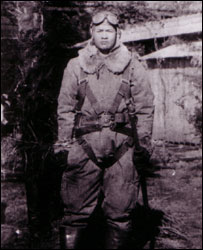 Taiwan was a Japanese colony from 1895 through the end of WWII. Formosa (Taiwan) produced sugar and rice that was exported to Japan, and many of these sugar mills were converted to produce butanol for aviation gasoline. Taiwan factories refined a tenth of Japan's aluminium.
Taiwan was a Japanese colony from 1895 through the end of WWII. Formosa (Taiwan) produced sugar and rice that was exported to Japan, and many of these sugar mills were converted to produce butanol for aviation gasoline. Taiwan factories refined a tenth of Japan's aluminium.
The island contained approximately 60 wartime airfields. Toward the end of the war Taiwan came under air attack from Allied aircraft (see photos below). The war ended prior to the US implementing its Taiwan invasion plan.
The "Taiwan Battalion" ("Takasago Giyutai") consisted of Taiwanese who volunteered (click here) to join the Japanese Army. "...Although there were many Taiwanese volunteers in the Japanese Army, when the volunteers stopped volunteering, Japan started conscripting Taiwanese into its military forces." [22 Aug 2010] Bill Thayer (Shulinkou 1960-63, 76th/176th ASA)
(Left Photo-Click to Enlarge) Taiwanese World War II volunteer for Japan. photo credit: "Wikipedia"
The Imperial Japanese Navy operated heavily out of Taiwan. The "South Strike Group" was based out of the Taihoku Imperial University in Taiwan. Many of the Japanese forces participating in the Aerial Battle of Taiwan-Okinawa were based in Taiwan. Between 2,000 and 3,000 Japanese planes (including kamikazes) were available from 65 airfields on Taiwan. Taipei International Airport (Songshan Airport) was formerly a Japanese military airbase, the Matsuyama Airdrome, during the war. Peitou was a favored spot for Japanese army officers and kamikaze pilots would often spend their last nights in Peitou.
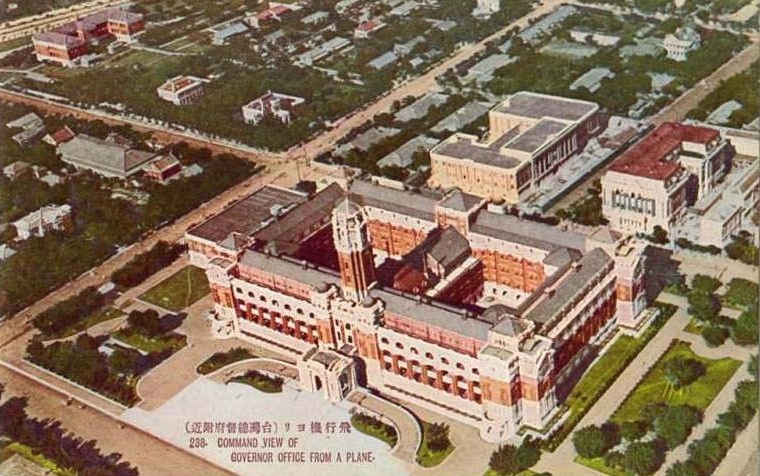 "Late in the war the Presidential Office Building in Taipei suffered heavy bombing from the Allied Powers and was severely damaged. On May 31, 1945, during an American air raid on Taipei, bombs hit the front left side, main lobby, and northern sections of the Taiwan Governor-General's Office. The fire burned for three days, damaging large parts of the building. Forty-five days after the air raid, Japan surrendered." ("Wikipedia")
"Late in the war the Presidential Office Building in Taipei suffered heavy bombing from the Allied Powers and was severely damaged. On May 31, 1945, during an American air raid on Taipei, bombs hit the front left side, main lobby, and northern sections of the Taiwan Governor-General's Office. The fire burned for three days, damaging large parts of the building. Forty-five days after the air raid, Japan surrendered." ("Wikipedia")
(Right Photo-Click to Enlarge) Aerial view of the Presidential Office Building in Taipei. image courtesy of "Taipics.com"
Bill Thayer (Shulinkou, ASA '60-'63): "Taiwan was a colony of Japan from 1895 until 1945 with the (Click Here) Treaty of Shimonoseki in 1895, when the Chinese Imperial government ceded sovereignty over Taiwan to Japan in perpetuity. The same was true of Korea for which the Japanese government recently this year (2010) apologized to the South Korean government, and to the chagrin of North Korea, which did not receive an apology. Nor did Taiwan or China receive any apology for Japanese colonization." [22 Aug 2010]
Linkou's Temple of "Divine Protection" in World War II
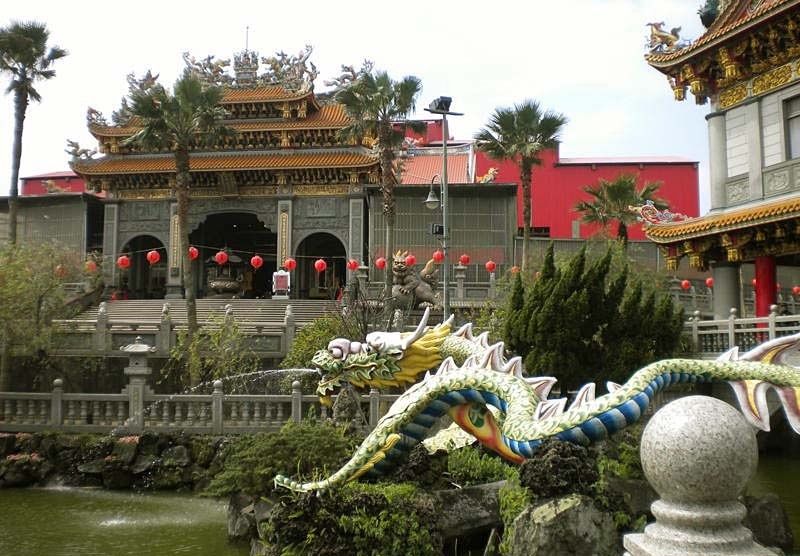 Ken Ashley (Dawg Flight '74-'77): "There is a very popular Buddhist temple in Linkou, the Zhu Lin Shan Kuan Yin ("Guanyin") Temple (竹林山觀音寺 "Kuan Yin Bamboo Forest Mountain Temple"), that has grown over the years. My wife and I visited it last year and were told the following:
Ken Ashley (Dawg Flight '74-'77): "There is a very popular Buddhist temple in Linkou, the Zhu Lin Shan Kuan Yin ("Guanyin") Temple (竹林山觀音寺 "Kuan Yin Bamboo Forest Mountain Temple"), that has grown over the years. My wife and I visited it last year and were told the following:
"During WWII when the Americans were bombing all the Japanese military installations in the Linkou area (see photos below), no bombs landed on or near the temple. Whenever the air raid siren went off, the local people would rush to the Linkou temple for protection. The local people knew the nearby airfield was the main target of the air attacks, but they also knew there were bombs that missed their mark as non-military targets were hit. According to the locals, the American pilots used the temple as a navigation point prior to their attacks on the airfield.
Because no bombs fell on the temple during the bombing raids, the temple became famous in the local area as having "divine protection". Therefore, over the years, people have gone to the temple to pray for protection and good fortune. When local people would become prosperous, they would donate large sums to the temple. As a result, the current expansion of the temple is due to the large numbers of donations." [July 27, 2008]
(Left Photo) March 2010 photo of the historic Kuan Yin ("Guanyin") Temple, one of the oldest temples in Taiwan. photo by John Hite
Ken Ashley: "...there is, in fact, an area of Linkou Township called 'Shu Linkou'. Apparently, the boundary lines for Shu Linkou and Nan Shipu (Lamsepo) met near the southern end of the old Japanese WWII runway (Lamsepo Airdrome). This may be from where Shu Linkou Air Base received its name. Undoubtedly, Lamsepo Airdrome (see WWII photos below) received its name from the fact it lay in the Lamsepo (Nan Shipu) area." [Aug 01, 2008]
American B-25 Bomber Attacks on Linkou April 1945
The photos below show the Japanese Lamsepo Airdrome at Linkou being attacked by North American B-25 Mitchell twin-engine medium bombers and gunships on Saturday, April 14 and Monday, April 16, 1945 (based upon the dates and mijssion notations written on the back of the photos). The attacks took place four months prior to the war's end on August 14, 1945. Kuan Yin Mountain north of the Linkou airfield is clearly visible in the background of the photos. The editorial comments are based on factual historical events and photo notations by the U.S. military.
B-25 Bomber Attack on Linkou April 14, 1945
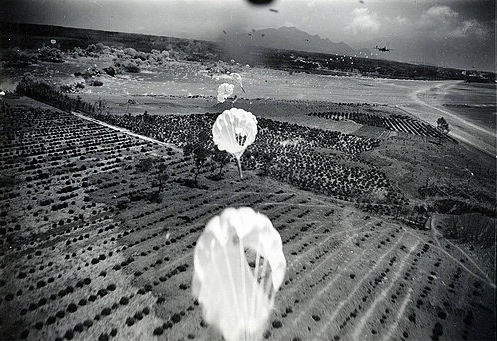
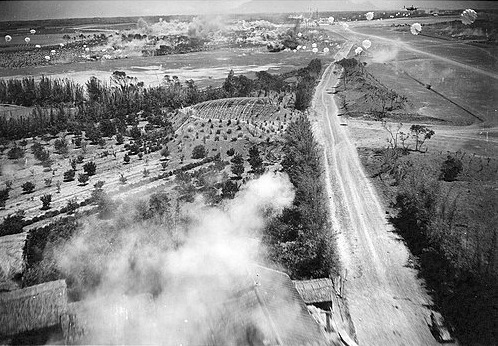
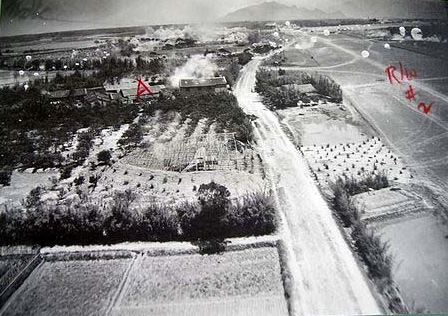 Photo credits: U.S. military photo archives, provided by Ken Ashley (Dawg Flight 1974-77) (Map-below right) 1971 Map of Taiwan, Nan Hua Publishing Co., Ltd, Taipei
Photo credits: U.S. military photo archives, provided by Ken Ashley (Dawg Flight 1974-77) (Map-below right) 1971 Map of Taiwan, Nan Hua Publishing Co., Ltd, Taipei
(Click on Photos to Enlarge)
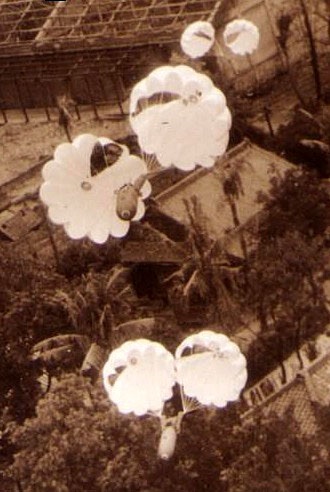 (1.-above) American B-25 Mitchell bombers attacking the Japanese Lamsepo Airfield at Linkou, Saturday, April 14, 1945. The "parafrag" bombs (parachute-retarded fragmentation bombs) in the foreground are being dropped from the bomb bay of a B-25. A B-25 on a strafing run over the airfield is visible in the upper right background just to the right of Kuan Yin Mountain (Mt. Kuanyin). Tracer rounds from the B-25's nose mounted .50-caliber machine guns are also visible. Lamsepo A/D (airdrome) and date are noted on the back of the photo. (Photos taken by a B-25 nose-mounted camera.)
(1.-above) American B-25 Mitchell bombers attacking the Japanese Lamsepo Airfield at Linkou, Saturday, April 14, 1945. The "parafrag" bombs (parachute-retarded fragmentation bombs) in the foreground are being dropped from the bomb bay of a B-25. A B-25 on a strafing run over the airfield is visible in the upper right background just to the right of Kuan Yin Mountain (Mt. Kuanyin). Tracer rounds from the B-25's nose mounted .50-caliber machine guns are also visible. Lamsepo A/D (airdrome) and date are noted on the back of the photo. (Photos taken by a B-25 nose-mounted camera.)
 (Left Photo).Close-up of parafrag bombs (parachute-retarded fragmentation bombs) being dropped from the bomb-bay of a B-25. The parachutes slowed the descent and detonation of the bombs to prevent damage to the bombers flying at low altitudes.
(Left Photo).Close-up of parafrag bombs (parachute-retarded fragmentation bombs) being dropped from the bomb-bay of a B-25. The parachutes slowed the descent and detonation of the bombs to prevent damage to the bombers flying at low altitudes.
(Map on Right). Linkou is shown a few miles northwest of Taipei on the map. Mt. Kuanyin (Kuan Yin Mountain) is shown five miles northeast of Linkou. The Tamshui River is shown north of Mt. Kuanyin. (1971 map)
(2.) A B-25 is strafing the buildings, possibly Japanese barracks, in the foreground. Smoke is spewing from the buildings after being hit by .50-caliber machine-gun fire. Multiple bomb explosions, parafrag bombs, and tracers from B-25s are visible in the distance. (Photos taken by a B-25 nose-mounted reconnaissance camera.)
(3.) Lamsepo Airfield's runway labeled "#2" by U.S. military is on the far right. The buildings, possibly barracks (also shown in the previous photo) labeled "A" by the U.S. military are smoking after being strafed. Bomb explosions, parafrag bombs, and a B-25 on a strafing run are visible in the background. Visible to the right of Kuan Yin Mountain is another B-25 and its tracer rounds. A dummy Japanese aircraft is visible beneath the camouflage netting (center). (Photos taken by a B-25 nose-mounted reconnaissance camera.)
B-25 Bombers Return to Lamsepo Airdrome (Linkou) April 16, 1945
"Twenty-six B-25s made it to Lamsepo on the 16th, hoping to take some of the pressure off the American task force engaged in supporting the Okinawa campaign, The headquarters buildings, dispersals and several parked aircraft were bombed, but returning crews reported that many of the Jap planes were dummies. Several B-25s were holed by AA and machine-gun fire and the 499th Bombardment Squadron lost a navigator, 2/Lt. Allen H. Barnas, who bled to death on the way home after being hit by shrapnel." Source: "Warpath Across the Pacific, The Illustrated History of the the 345th Bombardment Group During World War II", Lawrence J. Hickey.
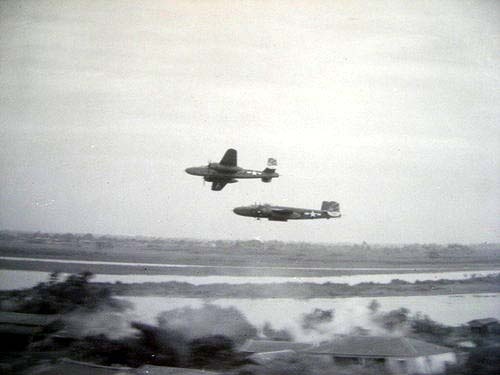
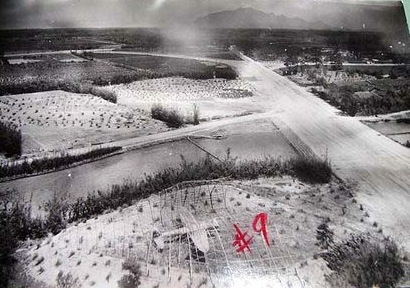
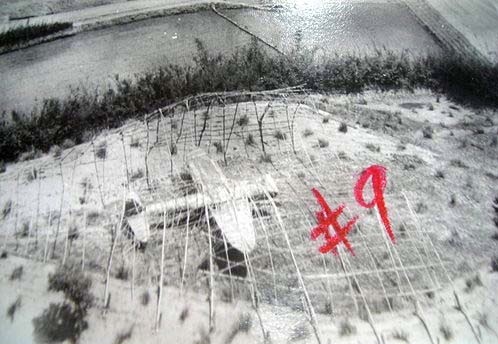 (Click on Photos to Enlarge) Photo credits: U.S. military photo archives, provided by Ken Ashley
(Click on Photos to Enlarge) Photo credits: U.S. military photo archives, provided by Ken Ashley
NOTE: The photos above were taken by a B-25 nose-mounted camera Monday, April 16, 1945, two days after the previous attack on Lamsepo Airdrome, April 14, 1945 ((see photos above). Hand written notations on the back of the photos reference Lamsepo A/D (Airdrome) and the dates of the missions.
(1.) B-25 Mitchell Bombers over Taiwan, possibly with the 499th Bombardment Squadron or the 17th Photographic Reconnaissance Squadron.
(2.) A B-25 nose camera captures the Japanese Lamsepo Airfield's runway at Linkou on the right and Kuan Yin Mountain in the upper right background. Tracer rounds from a B-25 or ground-fire are visible in the upper far right. A dummy Japanese aircraft, labeled "#9", is under camouflage netting in the foreground. (3.) Close-up of the dummy aircraft in the previous photo, labeled "#9".
Bomb Craters at Linkou: 1955 to 1956
Delano "Del" Sylvester, Major USAF Retired (Shulinkou: May '55 to Aug '56): "Several hundred yards southwest of Lin Kou was the hamlet Shulinlin, where we could purchase the famous rubber boots worn by all airmen. The path to Shulinlin went through a large tea patch. Close to the walking path were one or two large craters caused by errant 500 pound bombs dropped from USAAF B-24 or B-25 bomber aircraft during World War II (photos above). Japanese Army airfields in Formosa were bombed relentlessly during the last year of the war in preparation for a planned invasion..." [Jan. 15, 2005] .
American Air and Naval Action Against the Japanese on Taiwan
B-25 Bomber Attack on Taichung 1945
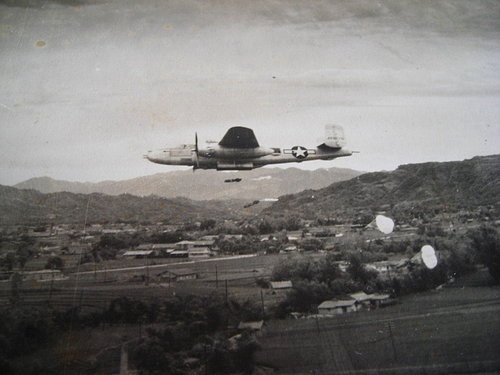
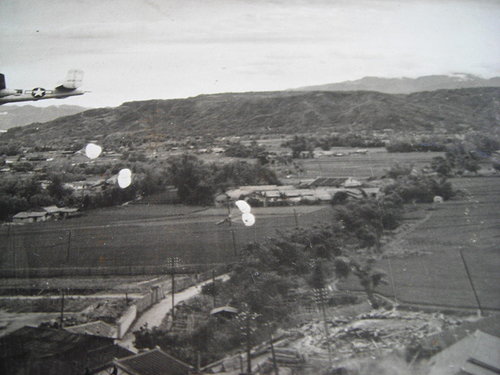
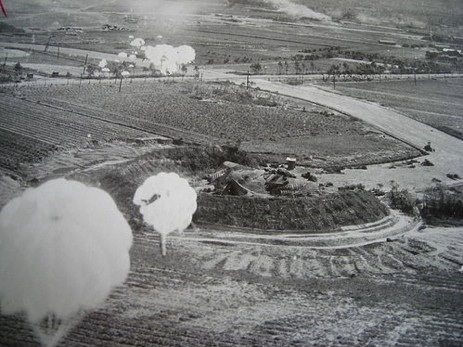
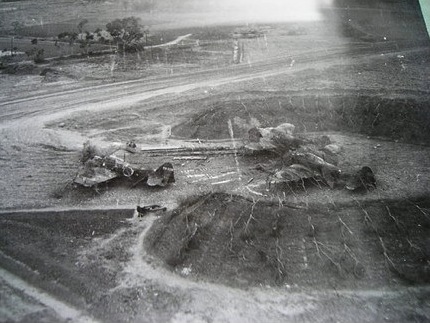 (Click on Photos to Enlarge) U.S. military photo archives
A B-25 Mitchell Bomber dropping "parafrag bombs" (see below) on the Japanese Toyohara Air Base, Taichung in 1945.
(Click on Photos to Enlarge) U.S. military photo archives
A B-25 Mitchell Bomber dropping "parafrag bombs" (see below) on the Japanese Toyohara Air Base, Taichung in 1945.
The B-25's six nose-mounted .50-caliber machine guns used for strafing runs are visible in the first photo (far left).
The North American B-25 Mitchell Bomber
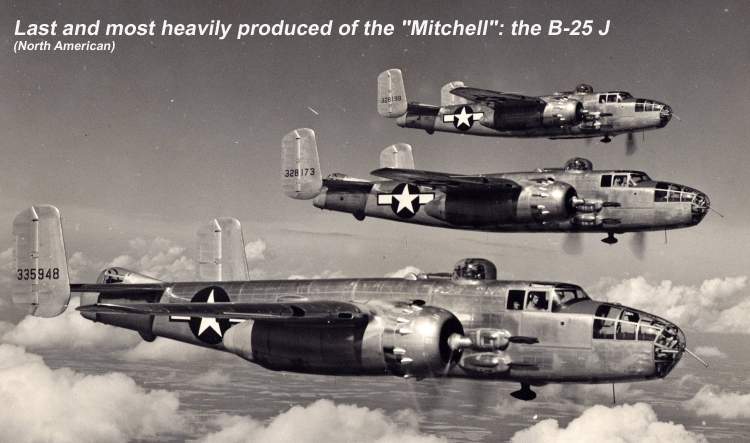
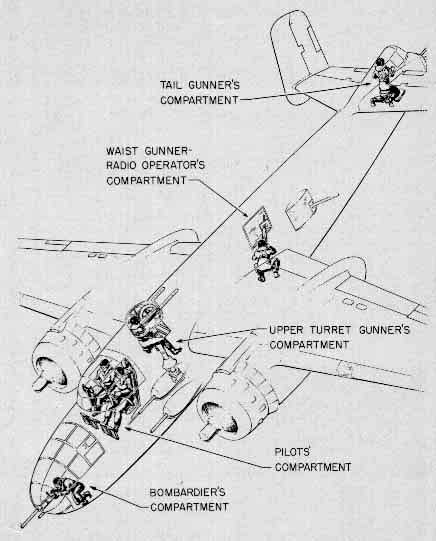
The twin engine North American B-25 Mitchell medium bomber manufactured by North American Aviation was used frequently in the Southwest Pacific theater on treetop-level strafing (as a gunship) and "parafrag" (parachute-retarded fragmentation bombs) bombing missions against Japanese airfields.
The parachutes slowed the descent and detonation of the "parafrag bombs" to prevent damage to the bombers on low-level bombing runs. The "parafrag bombs" floated to earth beneath parachutes to detonate right above the ground, spraying fragments in every direction (see photos above).
Depending on the version, a B-25 Mitchell gunship carried up to an impressive total of 18, .50-caliber machine guns with six to eight .50s mounted in its nose for strafing missions and the other .50s located throughout the plane and in turrets and cheek blisters. Later versions would bring the total forward firing capabilities to 14 forward firing .50 caliber machine guns that would make the superstructure of an enemy ship dissolve as the armor-piercing incendiary projectiles melted it. No other bomber of World War II carried as many guns.
(Left Photo) B-25J bombers with side-mounted .50 cal. guns in cheek blisters. (Right Image) B-25 interior.
photo credits: USAF military archives
U.S. Bomber Attack on Kaohshiung Harbor 1944
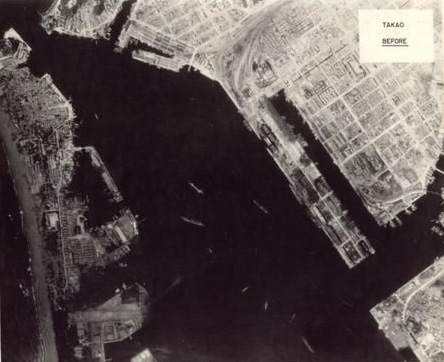
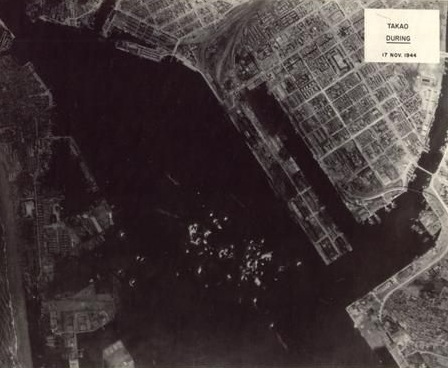
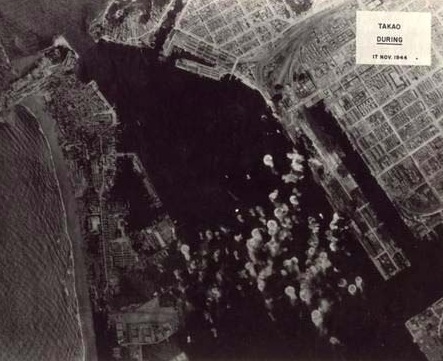 (Click on Photos to Enlarge) U.S. military photo archives
A U.S. aircraft attack on Kaohsiung (Takao) Harbor Nov. 17, 1944.
(Click on Photos to Enlarge) U.S. military photo archives
A U.S. aircraft attack on Kaohsiung (Takao) Harbor Nov. 17, 1944.
Important Japanese military bases and industrial centers throughout Taiwan, like the naval port of Kaohsiung, were targets of heavy American bombing. On May 31, 1945, during an American air raid on Taipei, bombs hit the front left side, main lobby, and northern sections of the Taiwan Governor-General's Office building (later renamed the Presidential Office Building) occupied by the final Japanese Governor-General, General Rikichi Andō. The fire burned for three days, damaging large parts of the building. Japan surrendered forty-five days after the bombing.
U.S. Navy Action on Taiwan 1943 and 1944
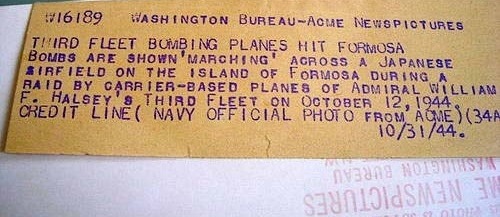
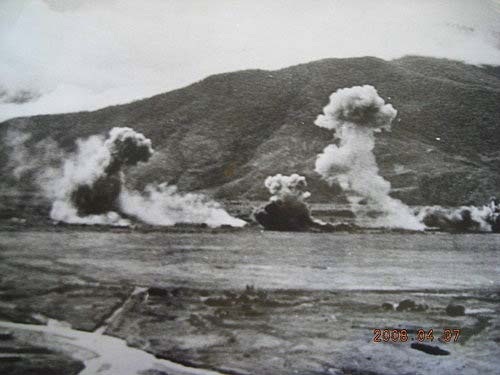
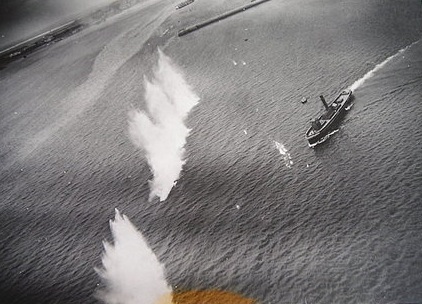
 (Click on Photos to Enlarge) U.S. military photo archives
(Click on Photos to Enlarge) U.S. military photo archives
(Above Photos) Carrier-based planes of Admiral Halsey's Third Fleet bomb a Japanese airfield on October 12, 1944 during the first day of three days of attacks on Formosa (Taiwan). Halsey's flagship was the famed carrier USS Enterprise. "After the third day, the Americans had destroyed more than 500 Japanese planes [on the ground and in the air] and done much damage to airfields and all manner of shore installations on Formosa." (The Pacific Campaign, The U.S.-Japanese Naval War 1941-1945, Dan van der Vat ). The Third Fleet continued to attack Taiwan through the end of the war. U.S. submarines patrolled off Taiwan and the Taiwan Strait for most of the war sinking merchant vessels, troop transports and Japanese warships.
Japanese Prisoner of War Camps on Taiwan
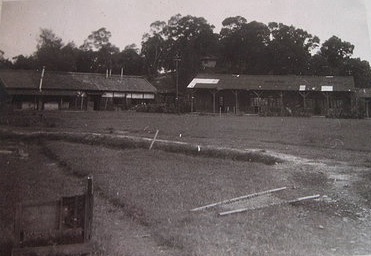
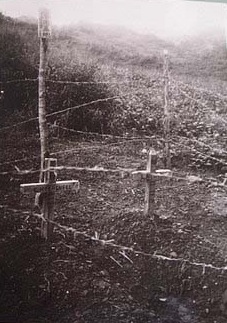
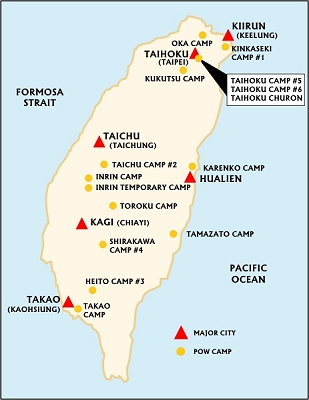 (Click on Images to Enlarge) photo sources: (1. & 2.) U.S. military photo archives. (3.) "POWtaiwan.org"
(Click on Images to Enlarge) photo sources: (1. & 2.) U.S. military photo archives. (3.) "POWtaiwan.org"
1.) Shirakawa POW camp, Taiwan. 2.) Cemetary, Oka POW camp, Taiwan. 3.) Map of Taiwan POW camps.
Taiwan played a significant part in the system of Japanese prisoner of war camps that extended across Southeast Asia between 1942 and 1945. There were 16 POW camps including two evacuation camps located in Taiwan (ref. map above). Sadistically supervised by the Japanese and Taiwanese, allied POW's (American, British, Dutch Australian, and Canadian) were brutally enslaved at various locations, including the copper mine southwest of Keelung. The tragic Allied bombing of the Japanese hellship Enoura Maru took place at Takao (Kaohsiung) Harbor, Taiwan on January 9, 1945, resulting in the loss of more than 300 American POW lives. (source: Taiwan POW Camps Memorial Society, "powtaiwan.org")
Additional historical information and details (videos and site links) about the Taiwan POW camps in WWII, including the brutal execution of 14 American airmen at the Taihoku Prison in Taipei at the war's end, can be found at:
Taiwan POW Camps Memorial Society website (Click Here). and Taipei Air Station blog (Click Here).
 Taiwan was a Japanese colony from 1895 through the end of WWII. Formosa (Taiwan) produced sugar and rice that was exported to Japan, and many of these sugar mills were converted to produce butanol for aviation gasoline. Taiwan factories refined a tenth of Japan's aluminium.
Taiwan was a Japanese colony from 1895 through the end of WWII. Formosa (Taiwan) produced sugar and rice that was exported to Japan, and many of these sugar mills were converted to produce butanol for aviation gasoline. Taiwan factories refined a tenth of Japan's aluminium. "Late in the war the Presidential Office Building in Taipei suffered heavy bombing from the Allied Powers and was severely damaged. On May 31, 1945, during an American air raid on Taipei, bombs hit the front left side, main lobby, and northern sections of the Taiwan Governor-General's Office. The fire burned for three days, damaging large parts of the building. Forty-five days after the air raid, Japan surrendered." ("Wikipedia")
"Late in the war the Presidential Office Building in Taipei suffered heavy bombing from the Allied Powers and was severely damaged. On May 31, 1945, during an American air raid on Taipei, bombs hit the front left side, main lobby, and northern sections of the Taiwan Governor-General's Office. The fire burned for three days, damaging large parts of the building. Forty-five days after the air raid, Japan surrendered." ("Wikipedia")






















